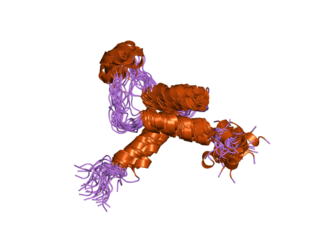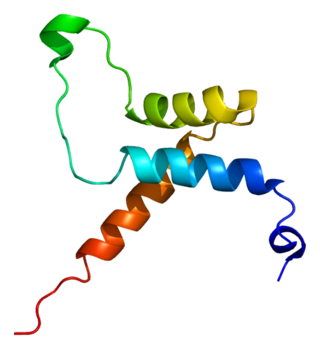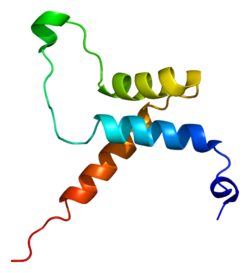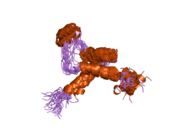
Human placental lactogen (hPL), also called human chorionic somatomammotropin (hCS), is a polypeptide placental hormone, the human form of placental lactogen. Its structure and function are similar to those of human growth hormone. It modifies the metabolic state of the mother during pregnancy to facilitate energy supply to the fetus. hPL has anti-insulin properties. hPL is a hormone secreted by the syncytiotrophoblast during pregnancy. Like human growth hormone, hPL is encoded by genes on chromosome 17q22-24. It was identified in 1963.

The steroidogenic factor 1 (SF-1) protein is a transcription factor involved in sex determination by controlling activity of genes related to the reproductive glands or gonads and adrenal glands. This protein is encoded by the NR5A1 gene, a member of the nuclear receptor subfamily, located on the long arm of chromosome 9 at position 33.3. It was originally identified as a regulator of genes encoding cytochrome P450 steroid hydroxylases, however, further roles in endocrine function have since been discovered.

Peroxisome proliferator- activated receptor gamma, also known as the glitazone reverse insulin resistance receptor, or NR1C3 is a type II nuclear receptor functioning as a transcription factor that in humans is encoded by the PPARG gene.

TEAD2, together with TEAD1, defines a novel family of transcription factors, the TEAD family, highly conserved through evolution. TEAD proteins were notably found in Drosophila (Scalloped), C. elegans, S. cerevisiae and A. nidulans. TEAD2 has been less studied than TEAD1 but a few studies revealed its role during development.

Myocyte-specific enhancer factor 2C also known as MADS box transcription enhancer factor 2, polypeptide C is a protein that in humans is encoded by the MEF2C gene. MEF2C is a transcription factor in the Mef2 family.

Cyclic AMP-dependent transcription factor ATF-1 is a protein that in humans is encoded by the ATF1 gene.

Placental growth factor(PlGF) is a protein that in humans is encoded by the PGF gene.

YAP1, also known as YAP or YAP65, is a protein that acts as a transcription coregulator that promotes transcription of genes involved in cellular proliferation and suppressing apoptotic genes. YAP1 is a component in the hippo signaling pathway which regulates organ size, regeneration, and tumorigenesis. YAP1 was first identified by virtue of its ability to associate with the SH3 domain of Yes and Src protein tyrosine kinases. YAP1 is a potent oncogene, which is amplified in various human cancers.

Growth hormone 2 (GH2), also known more commonly as placental growth hormone (PGH) or as growth hormone variant (GH-V), is a protein that in humans is encoded by the GH2 gene. It is produced by and secreted from the placenta during pregnancy, and becomes the predominant form of growth hormone (GH) in the body during this time. Its cogener is growth hormone 1 (GH1), or pituitary growth hormone.

Transcriptional enhancer factor TEF-1 also known as TEA domain family member 1 (TEAD1) and transcription factor 13 (TCF-13) is a protein that in humans is encoded by the TEAD1 gene. TEAD1 was the first member of the TEAD family of transcription factors to be identified.

Transcription factor Sp4 is a protein that in humans is encoded by the SP4 gene.

D site of albumin promoter binding protein, also known as DBP, is a protein which in humans is encoded by the DBP gene.

Chorion-specific transcription factor GCMa is a protein that, in humans, is encoded by the GCM1 gene.

Collagen alpha-3(V) chain is a protein that in humans is encoded by the COL5A3 gene.

Transcriptional enhancer factor TEF-3 is a protein that in humans is encoded by the TEAD4 gene.

POU domain, class 2, transcription factor 3 is a protein that in humans is encoded by the POU2F3 gene.

Transcription factor AP-2 gamma also known as AP2-gamma is a protein that in humans is encoded by the TFAP2C gene. AP2-gamma is a member of the activating protein 2 family of transcription factors.

Nuclear factor -like factor 3, also known as NFE2L3 or 'NRF3', is a transcription factor that in humans is encoded by the Nfe2l3 gene.

Vestigial-like family member 3 is a protein that in humans is encoded by the VGLL3 gene.
The multigenic complex formed by the human growth hormone (hGH) and the human placental lactogen (hPL) takes part in the process of maternal and fetal metabolism regulation and the following growth and development of the fetus.
























